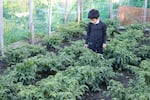Wendi Suni Yah Canul’s small garden is bursting with the vegetables she loves: tomatoes, cilantro and habanero peppers. Her community garden plot is located in Northeast Portland’s recently-built Cully Park, a 25-acre green space with soccer fields, a playground, and views of Mount St. Helens and Mount Hood.

Wendi Suni Yah Canul and her son Mario Valle Yah (6) pose in front of their community garden plot located in Northeast Portland's Cully Park on Oct. 7, 2021.
Monica Samayoa / OPB
“It’s not common in other places and I love this community because everything is very close to where I live,” she said through an interpreter.
But, a big problem is literally hanging over Yah Canul’s beloved park, her vegetable garden and her community: Air pollution drifting in from the Owens-Brockway glass-recycling facility about a mile away.
Yah Canul said she notices a strange odor in the air when she heads outdoors, and when she returns home, the odor lingers in her clothing. Yah Canul blames the chemicals for that smell and for her 6-year-old son’s recently-developed asthma. It’s a condition no one in her family has ever had before. It’s prompted Yah Canul to limit her son’s time playing outdoors. She started buying a special laundry soap to get the odor out of her family’s clothing.
“It worries me because I talk to my neighbors about what is going on and they have also felt the same,” Yah Canul said. “They also noticed the strange smell, as well.”
Yah Canul, who has lived in Cully for 15 years with her husband and four children, said the Owens-Brockway facility is causing more harm than good in her community.
The Cully neighborhood is what’s known as a fenceline community given their close proximity to pollution sources. They are exposed to transportation pollution, thanks to nearby Portland International Airport, U.S. 30 and a rail line. Also in the Cully neighborhood’s midst: three brownfields — previously developed industrial lands that are no longer in use and could be contaminated.
And then there’s the Owens-Brockway glass recycling plant, which was recently fined by state environmental regulators and, according to an advocacy group’s recent air modeling study, is releasing harmful amounts of pollutants and threatening the health of nearby neighborhoods, including Cully.
When asked via email what Owens-Brockway is doing to ensure the surrounding communities are not exposed to harmful chemicals, officials declined to be interviewed for this story or to provide a statement.
Cully residents, along with several environmental organizations, are calling on federal and state regulators to implement stricter air quality rules and hold the glass recycling facility accountable for polluting one of Portland’s more racially diverse and economically struggling communities. More than half the residents are people of color. Twenty-three percent of Cully residents are Latino, more than double the city’s overall percentage, according to Census data. The neighborhood also has almost twice the percentage of households living in poverty than does Portland as a whole.
The fight for clean air
The Owens-Brockway glass plant, owned by Owens-Illinois, Inc., melts down used beer and wine bottles in furnaces to create new glass containers. Every day on average the facility recycles more than 240,000 pounds of glass.

According to a recent air modeling study, the Owens-Brockway glass-recycling plant is releasing harmful amounts of pollutants, and threatening the health of nearby Northeast Portland neighborhoods of Cully, Sumner and Maywood Park.
Kristyna Wentz-Graff / OPB
Verde, an environmental justice organization located in the heart of Cully, said any of the Owens-Brockway recycling plant’s environmental benefits to the region come at the cost of nearby residents’ health.
“Living in this neighborhood, it’s obvious that something is in the air that is pretty distinct,” Verde’s energy, climate and transportation program coordinator Sergio Lopez said, citing accounts provided by Cully residents.
“There’s many, many people that I’ve talked to and know personally that they say, ‘my kid goes outside to play soccer and within 10 minutes our eyes get watery, the doctors assessed that our kids have asthma for X amount of years when there is no asthma traces in our family,’” he said.
Verde’s leaders say they trust the Oregon Department of Environmental Quality and have a good relationship with the agency, which enforces air-pollution standards in the state. But they’re also losing patience with the lengthy process it’s using to consider ways to clean up emissions from the Owens-Brockway plant.
“I think the state agency is following the rules and Owens-Brockway is replying to them because they are following the rules, but nothing is happening,” he said.
Continuous harmful amount of pollutants
The community groups working to reduce pollution from the Owens-Brockway plant have teamed up with Earthjustice, a public-interest environmental law organization. It recently commissioned a study that found the glass plant was emitting high levels of nitrogen oxides and sulfur dioxide into surrounding communities, potentially exceeding federal air-quality standards. In previous enforcement actions from DEQ the agency fined the glass plant more than $1 million, citing the company for multiple air-quality violations for particulate matter.
Todd Cloud, an air quality consultant with 22 years of experience, conducted the air modeling emissions research for the Earthjustice report. He said he was surprised to find such high levels of pollution being allowed from a facility located so close to neighborhoods.
“These are pretty high. This is reaching into the sensory perception range where you don’t need scientific instruments. You can just look out your car window. You should be able to see this,” Cloud said.
Earthjustice joined community-level environmental groups, including Verde, the Cully Air Action Team, and several other advocacy groups in petitioning the U.S. Environmental Protection Agency in 2020 to reconsider the renewal of the glass plant’s air quality permit. In the end, Earthjustice got some of what it wanted, but pollutants are still being emitted by Owens-Brockway while the review process continues to play out. Earthjustice attorney Ashley Bennett said its concerns include the airborne chemicals and other pollutants emitted from Owens-Brockway’s plant.
Clean-air advocates say they face an especially difficult challenge in getting tougher air-quality enforcement for Owens-Brockway because of its status as a “grandfathered” polluter. That status means it is not subject to the strictest clean-air standards. It’s a consequence of the plant’s long history. It was built in 1956 to manufacture and recycle glass bottles — which means it predates the 1970 Clean Air Act, the cornerstone law from which many air-quality regulations flow.
One result of Owens-Brockway’s special status is that it is exempt from submitting air-modeling analysis required under certain rules like the National Ambient Air Quality Standards (NAAQS). Air quality regulators charged with enforcing these standards, including the Oregon DEQ, only require new facilities or facilities undergoing major modifications to be evaluated for potential air-quality impacts.

Wendi Suni Yah Canul's son Mario Valle Yah, 6, looks at the family's abundance of habanero peppers in their community garden plot located in Northeast Portland's Cully Park, on Oct. 7, 2021.
Monica Samayoa / OPB
This kind of air-modeling analysis detects outdoor pollutants considered harmful to public health and the environment. Those pollutants include carbon monoxide, lead, ozone, particulate matter, nitrogen dioxide and sulfur dioxide.
Earthjustice’s own modeling showed the glass plant emissions exceeded allowable standards for some of these pollutants — even after Owens-Brockway’s Portland plant reduced operations in June to run just one of its four furnaces.
“If this was a facility that didn’t exist and they were applying for the permit and the facility was configured with this property line and these emissions and those stacks, the permit would be denied, outright,” Cloud said. “In fact as a consultant working for industry, I wouldn’t even turn it in.”
Corrective actions
In the face of criticism from Cully residents and their allies, DEQ says it’s doing what it can to navigate a complex set of requirements. DEQ Air Quality Administrator Ali Mirzakhalili said Owens-Brockway was able to renew its air-quality permit in part because source testing, like that required under the National Ambient Air Quality Standards, is not required for the renewal process.
“They have never done an ambient air quality assessment,” he said. “So once that’s identified it’s our responsibility to make sure that issue is remedied, so we’ve done so.”
The agency said it’s been working with the company to revise the facility’s air quality permit and in that process, is holding Owens-Brockway accountable under NAAQS. Over the summer, DEQ made what it considers significant changes to those requirements because of Earthjustice’s air modeling emissions.
Mirzakhalili said the agency is also looking into whether this facility is an anomaly or if there are similar situations around the state, in which facilities are being allowed to pollute more than is allowed under modern-day air-quality standards because nothing has come up to prompt DEQ to do more rigorous testing.
He said that while Earthjustice “did a credible job” with its study, DEQ’s own modeling and data, including from the agency’s limited number of air-quality monitors in the area, do not provide “any indication of ambient air quality exceedances” coming from Owens-Brockway.
A spokesperson from Owens-Brockway said because of “the ongoing nature of discussions” the company can not comment any further about what work it’s doing or on the modeling test report conducted by Earthjustice.
Seeking environmental justice
Verde’s Lopez said Cully’s continuing air-pollution problems show how much work remains to overcome the decades of disinvestment, in the form of neglect and abandonment, that has befallen communities of color. He said communities like Cully often get forgotten and it takes years for justice to reach those communities. When it comes to the air that Cully residents breathe, Lopez said, DEQ has an opportunity to make things right.
“We want immediate action, we want immediate change and we want the air to take a turn for the good,” he said.

A hazy sky hangs above Northeast Portland's Cully Park, with the Owens-Brockway glass recycling facility in the background.
Monica Samayoa / OPB
One solution being considered is to install filters that would trap harmful chemicals and airborne particulates. If Cully resident Wendi Suni Yah Canul had her way, that action would take the more immediate form of a complete shutdown of the Owens-Brockway plant. And it’s something she’s working toward as a part of Verde’s Líderes Verdes program. It’s a community group that builds environmental leaders and supports people like Yah Canul with training to help make positive changes in the community.
“I would like to have a town hall with our community to educate them and build more support to shut them down, because it’s too close to our community,” she said. “This place is beautiful and the community is so tight knit and we all know each other. It would be good for them to shut down so we can become a better community.”
Correction: Oct. 22, 2021. An earlier version of this story misstated the findings of an Earthjustice study of pollutants emitted from Portland’s Owens-Brockway glass recycling plant. The study found the glass plant was emitting nitrogen oxides and sulfur dioxide at levels that could potentially exceed federal standards.
